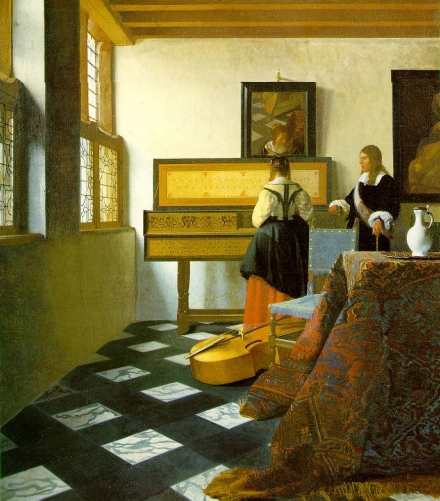Vermeer’s Musical Metaphors
Music as a metaphor for the creative act has been an iconic metaphor in the visual arts since at least the Renaissance, readily recognized by visual artists in all periods yet unseen by others. In Italy female artists like Sofonisba Anguissola, Lavinia Fontana and Tintoretto’s daughter, Marietta, all painted their self-portraits as they sat at a keyboard, the black-and-white keys a natural analogy for the tones of color that they would have lined up on their palettes. You will find other examples under the theme, Music as Art.

Vermeer, Lady Standing at a Virginal (c.1670-72) Oil on canvas. National Gallery, London
Click image to enlarge.
In this Northern example Vermeer has a young woman face the keyboard of a virginals with the lid opened up to reveal a landscape. This suggests that the woman looking directly at the "actual" artist painting the picture is Vermeer's alter ego and in playing the keyboard she "paints" the landscape in front of her. Others note that all the orthogonals meet at the woman's heart creating a unity to the picture from which there is no escape. We are inside Vermeer's mind where unity reigns.
The artist's monogram appears on the shaded side of the keyboard creating an analogy between the musical box and his picture-producing skull or brain-case.
Click next thumbnail to continue

Vermeer, Young Woman Seated at a Virginal (c.1670-72) Oil on canvas. National Gallery, London
Click image to enlarge.
The next picture, like the first in London's National Gallery, conveys similar meaning. Once again, the girl at a keyboard faces a painted lid while turning to look out over her shoulder the way a painter checks his model. Her actual model, of course, is the male artist, the other half of their androgynous mind. We know that because the artist's monogram behind her head and under the painting on the wall labels her his alter ego.
A cello in the foreground suggests in its proximity to the real artist, its bow at the ready, that he too will play music and paint.
Click next thumbnail to continue
The Guitar-Player is again of a similar subject. The young woman plays with a framed painting directly above her head. Is it too much to imagine that Vermeer intended a link between the painted trees above and the girl's curls streaming downwards as though, perhaps, roots of the tree?
Click next thumbnail to continue

Vermeer, The Concert (c.1665-6) Oil on canvas. Stolen from Isabella Stewart Gardner Museum, Boston.
Click image to enlarge.
In The Concert, an earlier painting stolen some years ago from its Boston museum, Vermeer inserts a remarkably large man who is not playing the keyboard. The girl at the left does that. He faces the painting on the keyboard's inside lid as though he has "painted" it, almost too close to the keyboard for his comfort. He represents the artist whose two muses, the performer and the singer on either side of him, help create the painting on the lid. Being inside the lid we are left to presume that the "painting" is just a mental image inside the artist's mind.
Click next thumbnail to continue
Lastly in a fifth painting about music from Vermeer's small oeuvre we can recognize the same metaphor at work. Instead of a painting on the wall there is a mirror to suggest that every painter paints herself. The empty chair and cello on the floor again suggest the nearby presence of the real artist. In addition, it has been argued that many of Vermeer's scenes, those with a checkered floor, take place in the same room redesigned for each work. That makes sense, not for the literal reasons others suspect, but for the fact that each image, no matter how different, is imagined inside the same mind, the artist's.
More Works by Vermeer
Notes:
Original Publication Date on EPPH: 01 Aug 2012. | Updated: 0. © Simon Abrahams. Articles on this site are the copyright of Simon Abrahams. To use copyrighted material in print or other media for purposes beyond 'fair use', you must obtain permission from the copyright owner. Websites may link to this page without permission (please do) but may not reproduce the material on their own site without crediting Simon Abrahams and EPPH.



